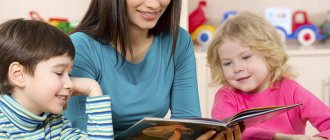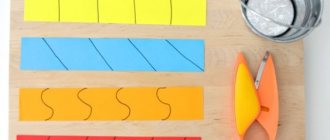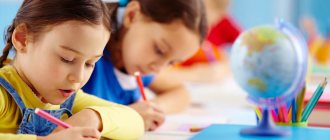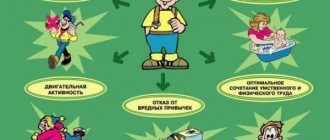Consultation for parents “Mathematics is interesting”
You often hear a child, approved by an adult, declare that he can count to 10, to 20. When he starts counting, he is in a hurry and misses numerals. The adults give him hints, and the child mechanically repeats everything they say. The question arises: Does the child really know how to count? Of course not. Here we see a mechanical memorization of numerals, behind which there is no main understanding. It is certainly necessary to teach preschoolers the basics of mathematics. This issue is especially acute now, when teachers and psychologists are tasked with creating the prerequisites for the transition to teaching children from the age of 6. A preschooler must be taught in such a way that the world around him becomes clearer.
Parents are called upon to help him with this, to show him significant interdependencies, to teach him to reason, compare, and contrast. Note that most parents, first of all, teach their children to count to 10, 20 and more. We'll have to upset them. Most often, such knowledge of children is useless, because the child has mechanically memorized the names and order of numerals and has practiced so-called abstract counting. As a rule, children have no idea of numbers.
How should you teach your child to count?
How to ensure that counting for him is not a set of words memorized in a certain order, but remains based on understanding the meaning of the number? Even in the younger group, the child learned to define different numbers of objects with the words “one” and “many.” At the age of 4 to 5 years, the kindergarten program provides training in counting to 5 based on comparison of 2 sets. So, for example, having homogeneous toys, you can show children that we have many animals, but among them 2 hares are less than 3 bears; 1 fox is less than 2 hares. There are many dolls. Offer to find out: “More small dolls or big ones.” Acquaintance with each new number is carried out on the basis of comparison of 2 sets. You place two rows of objects so that each of them is strictly one below the other. The child, comparing the number of objects, without counting, determines where there are more and where there are fewer. After this, you name the new numeral. There are 1 green cubes, and 2 red cubes. 2 is more than 1, 1 is less than 2. In the same way, introduce your child to the numbers 3, 4, 5.
Do not forget:
Our goal is to form a child’s understanding of numerals and the natural series of numbers by the beginning of school, and not just teach him how to count. To count, you need to take objects without distracting details, the objects must be interconnected (Christmas trees - mushrooms), (butterflies - flowers). Items should be familiar to children: buttons, sticks, etc. (no decorations). Show the children that it is more convenient to count objects with the right hand in the direction from left to right; while counting, each word - numeral must be related to only one object (the objects being counted are not named), teacher's demonstration. It is very important to teach the child to understand that “three” in this case does not refer to the name of the last object, but to the entire group of objects counted. You need to name objects, coordinating their name with the numeral in gender, number and case: “There are 2 cubes”, “There are only 3 apples”, “There are 5 mushrooms on the card”. First the numeral is called, then the noun. When a child learns to count objects, he can move them with his hand. Then you can move on to counting without moving your hand - visually.
For counting exercises, you can take different visual materials: toys, and later geometric shapes (circles, squares, triangles). Exercises need to be varied and set different tasks. For example: an adult puts 2 nesting dolls and 2 pyramids on the table. You ask: “How many nesting dolls are there?” How many pyramids are there here? “Which toys are there more? Less? How to make more pyramids? (does) Do it? How many pyramids are there? What toys are there fewer now? Why? How to make sure that there is an equal number of toys again.” Similar exercises can be done with different toys, outdoors and with natural materials: twigs, cones, pebbles, sticks, etc.
Focus on your children's actions
, the way they answer the questions you ask. Don’t rush your child and don’t rush to give advice yourself. Let the child develop his thinking and learn to be independent.
Show the children that the number does not depend on the size of the objects (2 adult chairs and 2 children's chairs, 3 large and 3 small dolls). Children often associate the number of objects with their spatial arrangement; they think that if some things take up a lot of space, then there are more of them in number than those that take up little space. The following exercises are needed: when you ask your child to count 2 groups of objects, arrange them differently.
For example:
in the top row there are 3 Christmas trees, located far from each other, and in the bottom row there are 4 fungi - closely located. What are more mushrooms or Christmas trees? How can you find out? You can count, or you can do it another way: put one mushroom under each Christmas tree, etc. teach your child to count or bring the number of objects you indicated: count out 3 buttons, bring the same number of cubes as I put on the table? Bring as many pyramids as I drew Christmas trees? It is useful to count objects by touch, with your eyes closed (how many potatoes are in the bowl? How many berries did mom put in her hand, etc.). Children will be happy to count the sounds: How many times did she clap her hands? How many times did you hit the drum with a stick? Place as many cubes as you want, how many sounds can you hear? You have to count out loud - 1, 2, 3.
To reinforce children’s quantitative concepts, play the following games with them:
- “WHAT HAPPENS IN 2?
Purpose of the game:
Practice children counting to 2.
Place 15 - 20 sticks on the table. The adult and the child take turns naming those items that always come in only 2 (shoes, stockings). For each correct answer, the player takes 2 sticks from the table.
Rules of the game:
1. If the answer is incorrect, you cannot take the chopsticks.
2. Each player counts the winning sticks independently.
3. The game ends when there are no sticks left on the table, then the players compare the method of applying the stick and determine the winner.
The game can be simplified: name objects, of which there can be 2: cucumbers, pencils, etc.
Make it more difficult: name something that does not exist in twos: paws on a cat, noses on a person, legs on a stool.
When the child gets acquainted with other numbers, you can play similar games: “What happens by 3, by 4.”
- "ORDER"
Purpose of the game:
Exercise children in the ability to count objects according to the named number.
The adult names a number familiar to the child, and the child brings the same number of toys. Then the child names the number, and the adult carries out the assignment. The correctness of the task is checked by the one who gave it. For each correctly completed task, the player receives a chip (small object). After the game, the number of chips collected is compared and the winner is determined.
Rules of the game:
1. The number is called only once.
2. The one who incorrectly fulfilled the order performs it a second time. An adult needs to make mistakes, but no more than by one (bring 5 items instead of 4).
Continue to teach children to distinguish and verbally indicate the size of objects. If the child is good at comparing the size of 2 objects, practice comparing the size of 3 objects.
Main attention
should be aimed at the size of the average object. The tale “The Three Bears” will help you well. Ask your child: Who is the biggest? Who is the smallest? How big is Nastasya Petrovna? Offer to choose chairs and dishes for them. Show your child 3 colored pencils of different lengths. Ask about the medium pencil. What is its length? (Medium) Long, short, shorter, longer - introduce these concepts.
Compare the thickness of books with different covers. It will be easier for the child to explain what book we are talking about.
Teach your child to arrange objects in descending order of their size: large, smaller, smallest, then in ascending order. To consolidate children's ideas about size, you can use modeling, drawing, and appliqué.
Sample tasks: sculpt three mushrooms of different sizes, draw a tall and a low tree, make a pyramid out of circles of different sizes, etc. Play the following games with the children:
- "SHOP"
Purpose of the game: to train children in the ability to distinguish the size of objects, to actively use the words in speech: long - short, low, wide, narrow, large - small.
Toys and objects of different sizes are selected for the game, for example: large and small dolls, long and short ribbons, wide and narrow cribs, high and low saucepans. The adult is the seller, the child is the buyer. To buy a toy, the child must name its size: “Please give me a long ruler,” “I need a tall pyramid,” etc.
The basic rule of the game: a toy or thing is given to the buyer only if its size is indicated.
- "PUT IN ORDER"
Purpose of the game:
to train children in the ability to arrange objects in descending or increasing order of their sizes.
There should be 10 - 15 objects of different sizes on the table (rings, pyramids, nesting dolls, paper mugs). At a signal, the adult and the child each take one object and arrange them by size (from smallest to largest and vice versa). The order of arrangement is agreed upon in advance. The winner is the one who, placing objects in a row, made fewer mistakes and completed his row faster.
Rules of the game:
1. Take one object at a time.
2. The selected item cannot be put back, but you can change its location in your row.
Children are already familiar with geometric shapes: circle, square, rectangle, triangle. Reinforce children's knowledge about shape in different types of activities: ask them to draw a square handkerchief, a rectangular towel, a quadrangular and a triangular flag. Teach children to correctly name the shapes used in construction: cube, cylinder, ball.
To reinforce children’s geometric concepts, play the following games:
- "FIND THE TRIANGLE"
Purpose of the game:
to train children in the ability to distinguish a triangle among other geometric shapes. Before the start of the game, each player has 15–20 different geometric shapes, including 8–10 triangles. At a signal, the players select triangles and place them in a row. The first one to select all the triangles wins. The game can be changed: choose squares, rectangles, circles.
- "WHO IS FASTER"
Purpose of the game:
exercise children in recognizing familiar geometric shapes.
Before the start of the game, each player has 10–20 pieces of different geometric shapes. They are mixed and covered with a sheet of paper. At the signal, each player opens his pieces and places them in a row: a row of squares, a row of circles, etc. The one who lays out 4 rows faster without mistakes wins.
Rule of the game:
start laying out figures only after the signal.
Continue to train children in the ability to navigate in space. The most convenient way to do this is in everyday life, giving the exercise a playful character or the form of an order: “Go to the sideboard and bring the cup that is on the right,” “what do you see to your right?” etc.
Children should be taught to navigate time, distinguish between parts of the day (morning, afternoon, evening, night); use words: today, yesterday, tomorrow, quickly, slowly.
Draw the children's attention to the changing parts of the day: evening is coming, it will soon be night, tomorrow we will go to the cinema. We read this book yesterday.
By age 5
children must distinguish and name: circle, square, rectangle, regardless of the size or color of the shapes. Distinguish and name a ball, cube, cylinder, correctly use words denoting spatial directions and time.
If you want to teach your child to count, buy 3 types of small toys, 10 pieces each (ducks, mushrooms, etc.) or choose from natural materials (pine cones, nuts, acorns, pebbles).
MAGAZINE Preschooler.RF
Consultation for parents “Mathematics for preschoolers”The main effort of both teachers and parents should be aimed at instilling in a preschooler the need to experience an interest in the very process of cognition, in overcoming difficulties, in independently finding solutions. It is important to cultivate and instill an interest in mathematics.
Acquaintance with size, shape, and spatial references begins in a child very early, already from infancy. At every step he is faced with the need to take into account the size and shape of objects, to correctly navigate in space, while for a long time he may not feel, for example, the need to count. Therefore, the knowledge that the child is most predisposed to assimilate is of paramount importance.
At preschool age, the foundations of the knowledge necessary
child at school. Mathematics is a complex science that
may cause some difficulties during schooling. In addition, not all children have an inclination and have a mathematical mindset, therefore, when preparing for school, it is important that preschoolers have the following knowledge in mathematics when they start studying:
- counting to ten in ascending and descending order;
- the ability to recognize numbers in a row and in sequence from one to ten;
- ability to form numbers of the first ten;
- recognize and depict basic geometric shapes (triangle, quadrangle, circle);
- the ability to divide an object into 2-4 equal parts;
- the child must be able to measure length, width, height using a string or sticks;
- comparing objects: more-smaller, wider-narrower, higher-lower.
In mathematics, it is not the quality of objects that is important, but their quantity.
Operations with numbers themselves are difficult at first and not entirely clear to the child. However, it is important to teach a preschooler to count using specific objects.
Games help your child become more comfortable with mathematics. In the process of playing, children learn complex mathematical concepts, learn to count, read and write, and the closest people - his parents - help the child develop these skills.
It is known that children really like doing small housework. Therefore, parents can teach their preschooler to count while doing homework together. For example, ask your child to bring you a certain amount of any items needed for the task. In the same way, you can teach your child to distinguish and compare objects: ask him to bring you a large salad bowl or a tray that is wider.
The kitchen is a great place to learn the basics of math. The child can count serving items while helping you set the table. Or, at your request, take three apples and one banana out of the refrigerator. You can diversify tasks endlessly.
Reading a book to a preschooler or telling fairy tales when they meet
numerals, ask him to put aside as many counting sticks as
for example, there were animals in history. After you have counted how many
there were animals in the fairy tale, ask who there were more, who were less, who
the same number. Compare toys by size: who is bigger?
a bunny or a bear, some smaller, some the same height.
Let your preschooler make up his own fairy tales with numerals.
Let the child say how many heroes there are in them, what they are like (who is bigger or smaller,
above and below), ask him to put aside the counting cards during the story
sticks. And then he can draw the heroes of his story and talk about them, make verbal portraits and compare them.
Very useful for developing a child's mathematical abilities
compare pictures that have both similarities and differences. Especially good
if the pictures have a different number of objects. Ask your preschooler how the pictures differ. Ask your child to draw different numbers of objects, things, animals, etc.
Draw children's attention to the shape of various objects in the world around them and their quantity. For example, the plates are round, the tablecloth is square, the clock is round. For older people: ask what shape this or that object resembles. Choose an object similar in shape to this or that figure. Ask what they have two of: two arms, two legs, two ears, two eyes, two feet, two elbows, let the child show them. And what one thing at a time.
Place the cups, ask how many plates, spoons and forks need to be placed if there are 3 or 4 people dining. Which side should the spoon and fork be on? They brought home fruits, apples and pears. What's more, you ask? What do I need to do. We remind you that this can be done without counting, by pairwise matching. If you count, you can compare the numbers (there are more pears, there are 5 of them, and there are fewer apples, there are 4 of them.) Cook the soup, ask how many vegetables are used, what shape and size they are.
On the way to kindergarten or home, look at the trees (higher, lower, thicker, thinner). Your child draws. Ask him about the length of the pencils, compare them in length, so that the child in life, in everyday life, uses words such as long-short, wide-narrow, high-low; thicker, thinner. It is important that these words are in children's vocabulary. The child must use the correct words for comparison by size by school.
Pay attention to the numbers that surround us in everyday life, in various situations, for example on a dial, in a calendar, in an advertising newspaper, on a telephone, a page in a book, the number of your house, apartment, car number.
Invite your child to look at the numbers on the phone with you, call them first in forward order, and then in reverse order, say your phone number; ask if the number has the same numbers. Ask to count as many items as the number shows, or show the number of how many buttons you have on your blouse.
Children learn not only to count, but also to navigate in space and time. Pay attention to this in your daily life. Ask your child what is to his left, to his right, in front and behind. Pay attention to when certain events occur, using the words: yesterday, today, tomorrow (what happened today, what happened yesterday and what will happen tomorrow). Call the day of the week, ask him; and what was yesterday will be tomorrow. Name the current month; if there are holidays or significant dates in this month, pay attention to this.
Introduce children to money and coins. So that the child knows how many rubles are contained in a particular coin, the number on the coin indicates the number of rubles, and the number of coins does not correspond to the number of rubles (money).
So, in a direct setting, sacrificing a small amount of time, you can introduce your child to many mathematical concepts, promote their better assimilation, maintaining and developing interest in mathematics.
| Next > |
Consultation for kindergarten teachers on FEMP
The importance of the formation of mathematical concepts in everyday life
Mathematics is a phenomenon of universal human culture and is extremely important in the development of the personality of a growing person. Mathematics today is one of the most important areas of knowledge of modern man. The widespread use of technology, including computer technology, requires a certain minimum of mathematical knowledge and understanding. From early childhood to old age, we are in one way or another connected with mathematics (even dialing a telephone number requires knowledge of numbers and the ability to remember digital sequences). In everyday life, in everyday life, in games, the child early begins to encounter situations that require the use of a mathematical solution (prepare a treat for friends, set a table for dolls, divide candy equally, etc.), knowledge of such relations as “many”, “few”, “more”, “less”, “equally”, the ability to determine and select the number of objects in a set. First, with the help of adults, then children independently resolve problems that arise. So, already at preschool age, the child becomes acquainted with mathematics and masters basic computational skills. In the mathematical training of preschoolers, along with teaching children to count, develop ideas about quantity and numbers within the first ten, dividing objects into equal parts, much attention is paid to operations with visually represented sets, taking measurements using conventional measures, determining the volume of granular and liquid bodies, development the children's eye, their ideas about geometric figures, time, and the formation of an understanding of spatial relationships. Children in the plot and content of games, as well as in game actions, reflect the area of reality familiar to them: the life of the family, kindergarten, events in social life, various types of adult labor. In such games, situations are sometimes created in which, fulfilling the role taken on himself, the child can perform a variety of counting and measuring actions. For example , in the game “Shop” he counts items, writes down his calculations, measures fabric, ribbons, ropes, etc.; -in the game “Transport”, establishes routes and flights of trains, planes, buses, etc. Mathematical content is included in fairy tales as necessary plot points on which its further development depends. (For example, you need to measure a certain number of steps or measures in one direction or another; to get to the castle of Koshchei the Immortal, you need to correctly “read” the letter in which the path plan is presented, etc.) Mathematical content can act as a special kind of contradictory situations requiring effective examination, formulation and testing of hypotheses. The condition for solving this kind of problem is children's experimentation organized with the help of a fairy tale. For example, you need to guess why a narrow car with traveling animals cannot pass through a wide but low gate. In the process of experimentation, children discover and highlight the concept of height as a special dimension. A fairy tale makes it possible to make mathematical content the material of a role-playing game, thereby determining its creative development. So, for example, the material can be quantitative relationships (the mother squirrel just can’t figure out how many mushrooms and berries she needs to bring to the hungry squirrels). Together with the squirrel, children discover that both baby squirrels and mushrooms can be counted with sticks. Mathematical content can act as a kind of rule for the actions of the heroes of a fairy tale. For example, in a fairy-tale travel game, you can get out of the maze only if you act in strict accordance with the mathematical content (a map-plan in which landmarks and the direction of movement are indicated, the numbers indicate the order of passing sections of the path, the length of those parts is measured using measurements or other sections of the route). In mathematics classes, children are very active in the perception of joke problems, puzzles, and logical exercises.
They persistently search for a solution that leads to a result. When an entertaining task is accessible to a child, he develops a positive emotional attitude towards it. The child is interested in the final goal: folding, finding the right shape, transforming. At the same time, children use two types of search problems: practical (actions in selecting, rearranging) and mental (thinking about a move, predicting the result). During the search, children show guessing, i.e. as if suddenly they come to the right decision. In fact, they find a way, a solution. Entertaining tasks with a mathematical meaning encourage children to use resourcefulness, ingenuity, and a sense of humor, and introduce children to active mental activity. 2.Games
1.Joke problems - entertaining game problems with a mathematical meaning. To solve them, you need to show resourcefulness, ingenuity, and an understanding of humor rather than knowledge of mathematics. Joke tasks for children 6-7 years old: You, me, and you and me. How many of us are there in total? (Two.) Grandma Dasha has a granddaughter Masha, a cat Fluff, and a dog Druzhok. How many grandchildren does grandma have? How to form a triangle on the table using only one stick? (Place it on the corner of the table.) How many ends does the stick have? Two sticks? Two and a half? (six.) Three sticks lie in a row on the table. How to make the middle one the outer one without touching it? (Move the outermost one.) How to form a square on the table using two sticks? (Put them in the corner of the table.) You need to divide 5 apples between 5 girls so that one apple remains in the basket. (One must take the apple along with the basket.) 2. Logical endings. If two are more than one, then one... (less than two). If Sasha left the house before Seryozha, then Seryozha... (left later than Sasha). If the river is deeper than a stream, then the stream... (smaller than a river). If the right hand is on the right, then the left ... (on the left). If the table is higher than the chair, then the chair... (below the table). 3. The riddles are entertaining. Riddles are of great importance in the development of thinking and imagination of preschoolers. When getting to know numbers, you can invite children to solve riddles that mention certain numerals. brothers follow each other, but do not find each other. (Months.) Five boys, five closets, the boys went into dark closets. (Fingers in gloves.) So as not to freeze, five guys are sitting in a knitted stove. (Mitten.) Four legs, but cannot walk. (table) Five brothers live in one house. (Mitten.) What becomes easier when it is inflated? (Ball.) I stand on four legs, I can’t walk at all. (Table.) Has four teeth. Every day he appears at the table and does not eat anything. What is this? (Fork.) 4. Problems in poetic form. A hedgehog was walking through the forest. I found mushrooms for lunch: two under a birch tree, one near an aspen tree. How many will there be in a wicker basket? May beetles lived under a bush by the river. Daughter, son, father and mother. Who can count them? The hedgehog gave the ducklings eight leather boots. Who among the guys can answer how many ducklings there were? 5. Poems-jokes: Ira is crying, I can’t stop it, Ira is very sad: there were exactly five chairs, and now there are four. The younger brother began to count: “One, two, three, four, five.” “Don’t cry!” said the baby, “After all, you’re sitting on fifth!” 6. You can also use counting rhymes to reinforce counting skills. For example: Nine, eight, seven, six, Five, four, three, two, one, We want to play hide and seek. We just need to find out which of us will go looking. 7. Proverbs and sayings can help form elementary mathematical concepts. Proverbs will also help when studying time representations. December ends the year, winter begins. Seven do not wait for one. Measure seven times, cut once. Such techniques and methods make counting the most interesting for children. They themselves do not notice how they master the necessary skills in the game. And practice shows that the knowledge and skills acquired in gaming activities are more durable, stable, conscious and arouse interest in actions with numbers even in everyday life. Conclusion Mathematics is a complex science that can cause certain difficulties during its formation. Regular use in mathematics classes of a system of game tasks and exercises aimed at developing cognitive abilities expands mathematical horizons, promotes mathematical development, improves the quality of mathematical preparedness for school, allows children to confidently navigate the simplest patterns of the reality around them and more actively use mathematical knowledge in everyday life. life. The use of games allows the child to discover new things and consolidate what has already been learned. Unbeknownst to themselves, during the game, preschoolers count, add, subtract, solve various kinds of logical problems that form certain logical operations. Thanks to games, it is possible to concentrate the attention and attract the interest of even the most disorganized children. At the beginning, they are captivated only by game actions, and then by what this or that game teaches. Of course, one cannot do without the educational process in mathematics classes. But we can make it fun and exciting...
We recommend watching:
Meeting of the parent club in the kindergarten “My Family” Meeting of the family club “Karapuz” (early age) on the topic “About health - seriously” Cognitive development of children 2-3 years old Theatrical activities in kindergarten
Similar articles:
How to get your child interested in reading
Introducing children 5-6 years old to fiction




